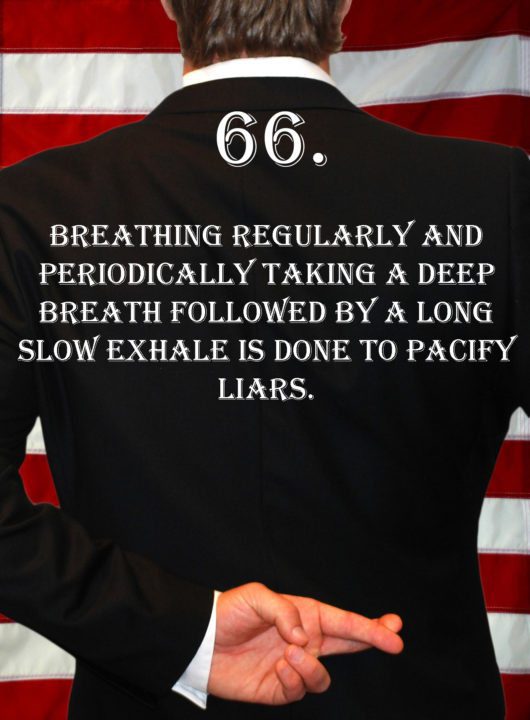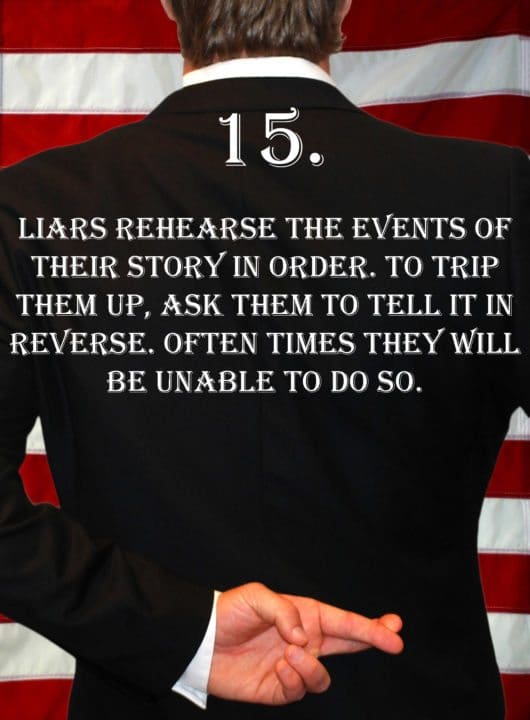
Deception Tip 66:
Breathing regularly and periodically taking a deep breath followed by a long slow exhale is done to pacify liars.
Listen To The Podcast!
E66 – Deep Breath – Deception Tips Podcast – Click Here To Subscribe
Podcast Transcript
Hello and welcome to the Deception Tips podcast where you will learn amazing cues to detect deceit that will help you read people like never before. I’m your host Spencer Coffman, let’s get started.
Welcome to episode 66 of the Deception Tips podcast. Thanks for making it this far, we’ve been having a great time learning all about how to read people, how to detect deception, how to know if someone is lying to you and how not to be taken advantage of by other people’s lies, or by other people in general. You’re learning how to find the truth and how to understand the truth.
You’re making those truthful behaviors, you’re taking in them and putting them from the unconscious to the conscious, so you are knowing exactly when they occur when they happen on you, when they happen on other people, etc.
I’m going to give you a little pointer here, take some time to practice all of these behaviors that you’ve learned about in the mirror. Practice listening to them, practice seeing them, practice what they feel like and what they look like on yourself then notice them on yourself.
Become more self-aware and notice how they feel, and what they look like when you are in conversations with others. Think about how you feel, what’s going on in your mind when that happens, are you lying, is something else going on, etc.
Then, when you see them on other people, think about how you felt when that behavior was on you and think about what they might feel before you decide they are lying.
Last week, we spoke about how liars prefer to conceal the truth rather than making up an entirely new story. This is because it is easier for people to remember something if it has already happened.
In fact, if they try to invent something then they have a much harder time remembering it because now they need to remember all of those fake details every single time they are asked about the story.
It could create a lot of problems, they could misstep, misspeak or do something to contradict themselves and tie themselves up. They’ll be twisted up in a web of lies or tangled and it won’t be good, they will be caught.
This is why they want to base their lie on the truth and they’ll just test or change a few details so that it’s much easier for them to remember. So, remember that liars want to conceal the truth rather than falsify an entirely new story.
Today, we are going to switch over to breathing patterns and how liars may breathe differently when they are telling lies. Why would they breathe differently?
Well, hopefully, you know the answer to that, it is because they are stressed, they are tense, and when they’re done telling a lie, they feel relieved that they finally got it out, that they finished, that they don’t have to think about it anymore.
They’re not anxious about telling the lie, remember being anxious about lying is a huge thing because lying is really not a natural behavior. We’re not born and we’re not good at lying, we do become better at lying with age because we obviously have more practice, the more times we lie, the better at lying we become.
You don’t have to worry about that, you don’t need to practice because, as we said before, the average person probably tells about a hundred to two hundred lies a day. So, you don’t even need to worry about it, let’s try to focus on getting that down to 50. Next, breathing when lying can be tense and stressful because of all of the things that are going on physiologically inside our bodies.
We’re very stressed, we’re very tensed, hyperventilating could be a part of that, anxiety, stress, all of this stuff is going to affect the breathing. So, that is what today’s deception tip is about, one thing before we dive into it is, that we’ve spoken about breathing before.
We did a while ago in deception tip number 54 when we talked about how people who attempt to conceal information, there’s the concealing again, remember they want to conceal the truth rather than falsify an entirely new story.
When they conceal information, they will breathe more rapidly like they’re hyperventilating. They’ll do a series of shallow breaths, then a long, deep breath after telling the lie, it’s almost like a sigh of relief.
They’re so relieved that it’s over with that they’re very happy, they take that long, deep breath and they can finally relax. So, you can pay attention to that and see if that’s going on and then think to yourself, why did they do that? Why did they take that long, deep breath? Did they just tell me a lie?
So, here we go, we’re going to dive into today’s deception tip, here it is, deception tip number 66. Breathing regularly and periodically taking a deep breath followed by a long, slow exhale is done to pacify liars. Here it is again, deception tip 66. Breathing regularly and periodically taking a deep breath followed by a long, slow exhale is done to pacify liars.
So, we’ve got a couple of things here, first off is that we’re pacifying, so this is a pacification gesture. This isn’t really a breath or a sigh of relief as in the last one we talked about, this is done to pacify, so what were some other pacification gestures that are related to breathing? Well, we have chimpanzee lips, where they would exhale or breathe through their chimpanzee lips as a pacification, stress relief.
That was episode 63, in case you missed it, it was only a few of them ago, hopefully, you remember. The other one is episode 46 where we spoke of pursed lips.
In this one, liars would puff up their cheeks like a pufferfish or a blowfish and then exhale slowly through the pursed lips to pacify the tension. So, that was definitely a pacification gesture related to the lips and to breathing.
So, we’ve talked about breathing several times within these other tips before but never solely on breathing other than deception tip 54, so that means that breathing obviously, it’s exactly like the lips.
Without breathing, you can’t lie, that means breathing is involved in every single lie that’s told. Well, obviously, because we need to breathe in order to speak, we need to breathe in order to live, so by right, breathing is going to be involved in every lie, it’s like a ‘duh’ fact.
Anyway, it doesn’t always mean that there are going to be unconscious signs in the breathing patterns that we use, so that’s tougher. Breathing is so hard to recognize because we can’t really hear it unless we’re close, we can’t see it. So, it’s something that you just have to go based on the muscular movements of the rest of the body on how they’re breathing.
Watch the shoulders, watch the chest, the diaphragm, their throat, etc. So, we’re going to dig a lot more into this breathing regularly and then a longer deep breath coming up right after this.
It doesn’t take long to read, and it’s filled with tips on detecting deception. It’s Spencer Coffman’s Deception Tips eBook and contains over 100 cues to detecting deception. Available on Spencer Coffman’s website or any major retailer.
Welcome back to Deception Tip episode number 66 where we’re talking about breathing patterns and how people breathe when they are lying. So, today we’re speaking of breathing regularly and then taking a long, deep breath later on, so it’s a long breath that’s done to pacify their stress and tension.
It’s not like a long, deep breath or a sigh of relief, this is more like the pursed lips, it’s a long slow exhale that’s done to release the stress and the tension involved in telling a lie.
So, to get you an idea of what type of breathing it is, we’re going to go through a little bit of an exercise. I think it’s a great one, it’s almost like a hypnosis type thing but it’s not really hypnosis, so there’s no danger if you’re driving or something.
You don’t have to worry because you’re not going to tune out or whatever the case may be, you won’t be in some kind of a trance or something. This is simply a breathing exercise and you’re going to see that it’s going to pacify and release a lot of stress and tension. So, this is a bonus, but this is the type of breath that we’re talking about in this tip and we’re going to run through it very quickly.
So, imagine that you are filled with all of this steam and anger and tension from telling a lie or trying to tell this lie and you’re worried about your stress, you’re anxious.
Maybe you have a stressful job or you’re very stressed right now or tense, the majority of people are carrying around a lot of stress and baggage and tension, so I’m sure this won’t be very difficult to go through for you.
So, you’re going to close your eyes, obviously, if you’re driving, you’re not going to close your eyes, but you close your eyes, you’re breathing regularly and then you’re going to take a big, deep breath and you’re going to slowly exhale. As you exhale, all of this tension and stress, and anger inside of you is going to come up from your toes.
You can feel it, it’s up from your toes, through your knees, up through your hips, as it comes up through your diaphragm you’re exhaling, you’re exhaling slowly.
You’re seeing all of this stuff being pushed out of your body, it’s coming down from your head, your shoulders, right out your mouth. It’s coming up through your chest and out your mouth.
As you see this being exhaled, there’s that red cloud of all of this stress, anger, tension, and anxiety that is leaving your body. Now you inhale this fresh, clean, blue air of peace, tranquility, and calm and as you exhale again, that final cloud of red stress, tension, and anxiety is leaving your body.
So, that is the type of breath we’re talking about, it’s regular breathing and then a long, slow exhale as everything is just leaving their body. So hopefully, you went through that little breathing exercise for the last minute or so, and it’s helped you and you feel a little better now by not being so stressed and anxious. You’ve inhaled that fresh, blue air and you’ve exhaled all that nasty red stuff and it’s just gone, you’re peaceful now.
That is how these liars are using this type of breathing, it’s to help them feel that peace and to give them a little bit of pacification, it’s to pacify the lying. So, it’s not like a sigh of relief, there’s a difference, so hopefully, you realize the difference because it’s tough for me to demonstrate on the air because you can’t really see me.
With a sigh of relief, you can clearly see all of the body language around that, in addition, you can probably hear it a little bit more too. Whereas with this breathing, it’s that long, slow exhale and regular breaths that aren’t as obvious.
So, that’s the difference there but keep in mind, that breathing is a little bit harder to notice. As I said, you need to be paying attention to the body language around the breathing.
When someone sighs what do you see? Typically, you see the shoulders relax, they go down. You probably see their head move a little bit, you might even hear a little vocalization in this sign, how about when someone’s breathing rapidly? What are you going to see?
You’re hyperventilating, you may see their shoulders up and down, up and down, you may see their diaphragm in out, in out, or their chest heaving back and forth.
So, you’re not going to see the breath, you might not even hear the breath, but you’re going to see the movements. When they have that sigh or not even the sigh when they have that pacification breath, what do you see? Well, in that other tip we talked about the pursed lips, so you might even see the lips doing something, the pufferfish action.
You might see chimpanzee lips, you never know, so you’re going to see the other things around the breathing, the support behaviors of breathing rather than the breathing itself. Then it is your job to understand what type of breathing they’re doing with those behaviors. How can you do that? Well, the only way you can understand that is if you first see it on yourself.
So, you need to understand the different ways that you breathe and the different things you do when you breathe, and how you may be feeling or what it may be doing for you. Then you can see those on other people and say, “Hey, when I breathe like this, I feel this way, so that person is breathing like that well they probably feel similar to how I felt.”
How can you know that? Well, we’re all human and for all humans, we have the same basic physiology and thought process, the same roots if you will, that means that you can be pretty certain that it’s similar.
It doesn’t mean it’s for certain, but you can use that as a basis and then go from there, so start asking questions, prodding them, having a conversation with them, and then you’ll see how right you were.
You’ll be able to see other body language signs that can confirm or deny what you were thinking. So again, that’s why it’s very important to look for patterns and clusters of behavior and always, if you see a behavior, continue to talk with them.
Poke and prod until you start seeing more and more behaviors because you want to see a pattern and a cluster to confirm or deny whatever it is you are thinking because that is the only way you can accurately detect deception, read people and spot lies.
So, I want to thank you for listening to this week’s episode of the Deception Tips podcast. I hope that you’ll share it with your friends, subscribe to the feed, check out the videos, the deception tips blog, and take a look at the books I have available and as always, tune in next week for a new deception tip.
Video Transcript
Hey guys, my name is Spencer Coffman, thank you for watching the deception tips videos, they’re all about teaching you how to read people and detect deception so that you will be able to tell if someone is lying to you. Today, we are going to talk about another sign that liars may display this could also be a sign of relief or pacification to release that stress and that tension that’s involved in telling a lie.
As you know, there’s that huge battle between the conscious and the unconscious, they’re fighting head-to-head, one wants the truth, one wants a lie, that’s creating all this internal stress and tension that’s going to blow up inside of someone. When they have this behavior, it’s more of a relief and relaxation to pacify away all that stress in tension and this one is about breathing.
So, here it is, this is deception tip number 66. Breathing regularly and periodically taking a deep breath followed by a long, slow exhale is done to pacify liars. We’ve talked about this before, something similar in Deception Tip number 54, which was Breathing Rapidly. How liars may breathe rapidly and then a long, slow exhale at the end to pacify or get rid of that stress or tension, it’s almost a hyperventilating then a sigh of relief.
This one is one step further than that, it doesn’t have that hyperventilation and that stress and tension. This is more of they are involved in the lie, they’re telling the lie, maybe they’ve just told the lie, the lie is about to be over. They’re starting to feel like they may be believed or maybe they’ve been caught and now they have this relief where they are now satisfied that they didn’t have to continue going through with it or that it’s over.
So, they take that deep breath and then a long, slow exhale to release that stress and tension, almost like they’re blowing out that steam. It’s a meditative breath, it’s a meditation gesture, it’s a breathing exercise that’s done to calm the mind and the spirit inside of them that’s boiling up with all of this tension and anxiety.
So, pay attention to this because it is something that you’re going to see, you’re going to see a lot of breathing, different actions, different things where people are taking deep breaths, they’re taking shallow breaths. They may be breathing really rapidly, they may be even what we talked about with taking a breath in through the nose and out through extended lips like the chimpanzee.
We’ve talked about that before in another deception tip where people can use that as more of a pacification gesture. Pacification gestures are very popular because people want to relieve that stress and that tension that’s involved in telling a lie. Nobody likes to be stressed all the time and if people are stressed all the time then there is a very good case that they actually might like to be stressed.
They might like that feeling of being stressed, it makes them feel important or something but when people are lying, they definitely don’t want to feel stressed. When they’re lying, they want to feel calm so that they can deliver that lie and that it will be more believable. When they are stressed or when they feel like they’re getting caught in this lie you’re going to start to see a lot more of these breathing gestures or these pacification gestures, these deep breaths, these meditative breaths.
So, when you see them, pay attention to them and think about okay, what’s going on? Is this person stressed? Yes, they are. Then think why are they stressed, are they stressed because they’re telling a lie or are they stressed because something else is going on? Two seconds ago, you just witnessed that their boss was screaming at them now they’re taking a deep breath out in the hallway.
Well, that’s a pretty legitimate reason why they may be stressed. Pay attention to the surrounding environment and the context of the situation to determine why they may be exhibiting that pacification gesture. What is the cause? Don’t find a symptom to treat it, find the cause and what’s going on and then use that to determine whether or not there is deception happening in that instance.
So, if this is your first time watching these videos, I’d love to have you subscribe to the channel on YouTube, feel free to comment with any questions you may have as well. Also, if you’d like some more information, we’ve got books, podcasts, and blog posts all available on spencercoffman.com that are dedicated to teaching you exactly what every body is really saying.
Until next time.






